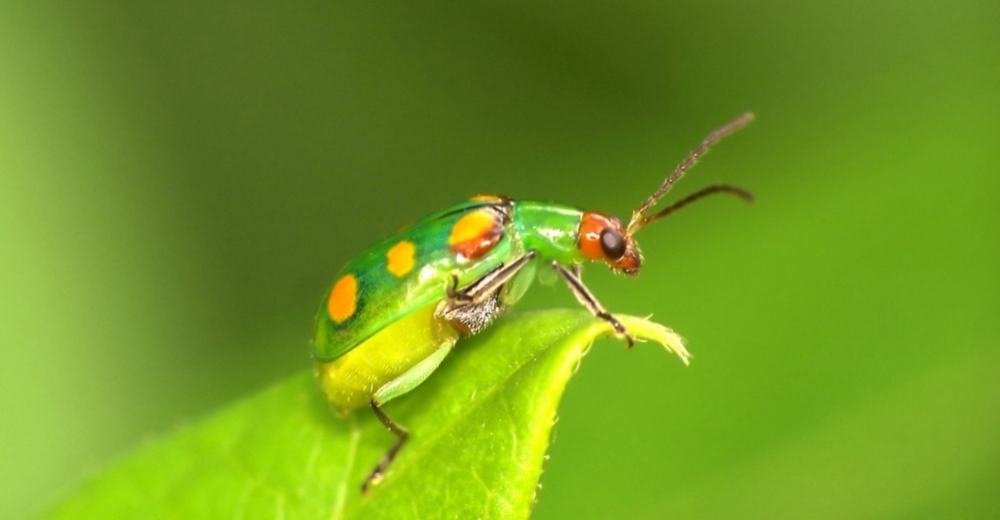

Researchers modeled corn rootworm’s lifecycle to predict and minimize crop invasions (photo: Pablo Dikro)
Researchers modeled corn rootworm's lifecycle to predict and minimize crop invasions.
Researchers modeled corn rootworm's lifecycle to predict and minimize crop invasions.

Researchers modeled corn rootworm’s lifecycle to predict and minimize crop invasions (photo: Pablo Dikro)
By Diego Freire
Agência FAPESP – A mathematical model developed by researchers at the Bioscience Institute (IBB) of São Paulo State University (UNESP), Botucatu campus, in Brazil could lead to new agricultural pest management strategies. The model, based on the behavior of the corn rootworm Diabrotica speciosa, is potentially applicable to the management goals of dispersing the insects and minimizing crop damage.
The model resulted from the research project Mathematical models on insect control, supported by FAPESP. It simulated the pest’s behavior patterns in four of the main host crops: dry beans, soybeans, potatoes and corn. The researchers considered the characteristics of these crops and variables such as larval development time, adult insect mortality in various landscapes, and oviposition rate (numbers of eggs laid per unit time).
The goal was to use the mathematical model to investigate ways of manipulating the insect’s habitat to regulate its population density naturally. “This is an integrated pest management strategy that sets out to manipulate the environment using the plants themselves as elements to control insect dispersal, keeping the insect population at levels that don’t affect crop growth and yield,” said Cláudia Pio Ferreira, a professor at IBB and principal investigator for the research project.
According to Ferreira, the benefits of integrated pest management include a reduction in pesticide use. “The harm agrochemicals do to human health and the increase in insect resistance to pesticides are avoided by the use of control measures that take into account the pest’s behavior patterns in the landscapes modeled,” she told Agência FAPESP.
Among the pest management solutions suggested by the model is the use of corn as a barrier for insect dispersal. “Diabrotica speciosa reproduces less when the host is corn because it has more difficulty persisting on and colonizing this crop. The mathematical simulations performed using this model showed that expansion of the pest is effectively halted when corn is inserted as a variable as well as other crops,” Ferreira said.
Based on the insect’s physiological and behavioral characteristics in interaction with the different spatial and temporal configurations of the landscapes they modeled, the researchers found that planting corn at the edge of a field on which other crops are grown reduces the probability of insect invasion still further. “This is the key to controlling insect population and protecting the crops concerned,” she said.
Interdisciplinarity
Researchers at the University of São Paulo’s Luiz de Queiroz College of Agriculture (ESALQ) collaborated on the model through the research project Ecological modeling applied to population dynamics and trophic interactions in insects of economic importance, also supported by FAPESP.
“Diabrotica speciosa is a pest that affects economic interests and causes drastic losses to small farmers. Chemical insecticides are still the most common method used to control it. This is where scientific research can help. Fieldwork is costly and time-consuming because of the practical difficulty of controlling insects, but the mathematical model predicts their behavior virtually, in this case using the parameters supplied by ESALQ,” Ferreira explained.
The researchers at IBB used the mathematical technique of cluster analysis, with several algorithms relating to the insect’s behavior patterns and crop configurations, to determine the probabilities of interaction between the pest and its hosts.
Using laboratory data on the insect’s lifecycle supplied by ESALQ, the researchers produced theoretical landscape layouts to model the insect’s interactions with plants during the larval and adult phases.
In addition to the probability that corn halts the pest’s expansion, the model showed that oviposition rate and the duration of the larval phase are the variables that are most sensitive to external factors such as temperature. “Understanding this sensitivity can help predict outbreaks,” Ferreira said.
The researchers at IBB are now working on mathematical models of patterns in dynamic landscapes, considering multiple factors and variables such as GM crops. “These landscapes are naturally dynamic. They’re influenced by several factors besides insect lifecycle and plant characteristics. Our forthcoming models will take this complexity into account,” Ferreira said.
According to Ferreira, the models can also be adapted to the behavior of other pests. “There are other insects of great agricultural importance that behave similarly to Diabrotica speciosa. Data on these pests are being collected so that we can extend the number of applications,” she said.
An article on the mathematical model for corn rootworm in dry beans, soybeans, potatoes and corn was published in the journal Landscape Ecology and is available at link.springer.com/article/10.1007%2Fs10980-014-0073-4.
Republish
The Agency FAPESP licenses news via Creative Commons (CC-BY-NC-ND) so that they can be republished free of charge and in a simple way by other digital or printed vehicles. Agência FAPESP must be credited as the source of the content being republished and the name of the reporter (if any) must be attributed. Using the HMTL button below allows compliance with these rules, detailed in Digital Republishing Policy FAPESP.





